外研版(2019)必修第三册Unit 3 The world of Science Starting out & Listening and Speaking 课件(共26张PPT,内镶嵌视频和音频)
文档属性
| 名称 | 外研版(2019)必修第三册Unit 3 The world of Science Starting out & Listening and Speaking 课件(共26张PPT,内镶嵌视频和音频) |  | |
| 格式 | pptx | ||
| 文件大小 | 30.4MB | ||
| 资源类型 | 教案 | ||
| 版本资源 | 外研版(2019) | ||
| 科目 | 英语 | ||
| 更新时间 | 2024-05-14 12:27:11 | ||
图片预览


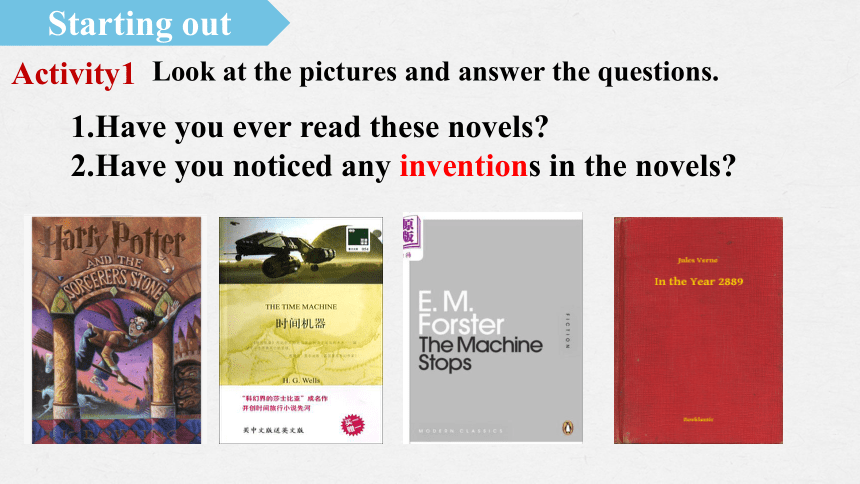
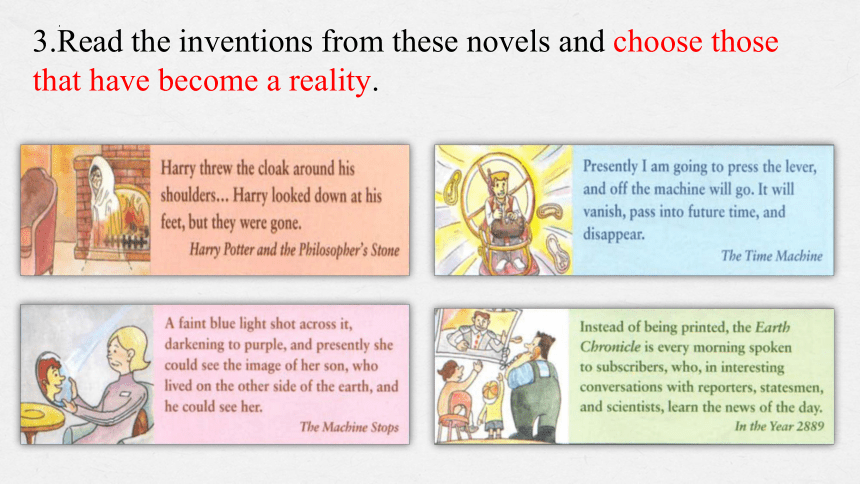
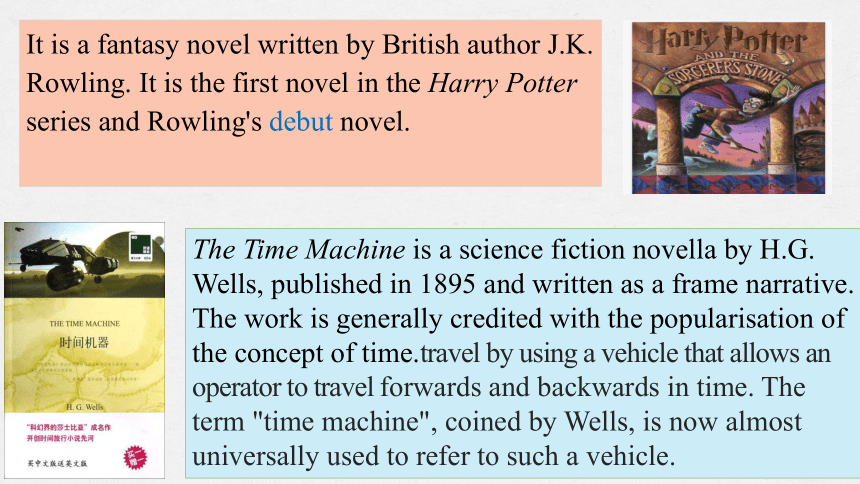
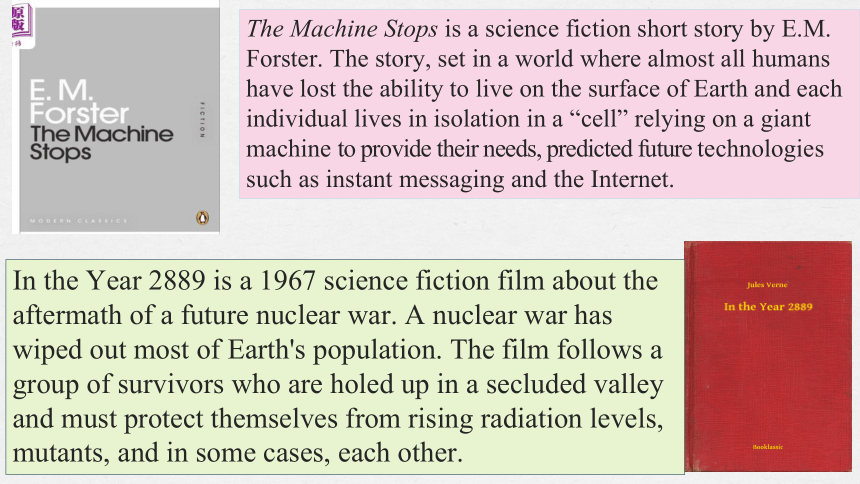
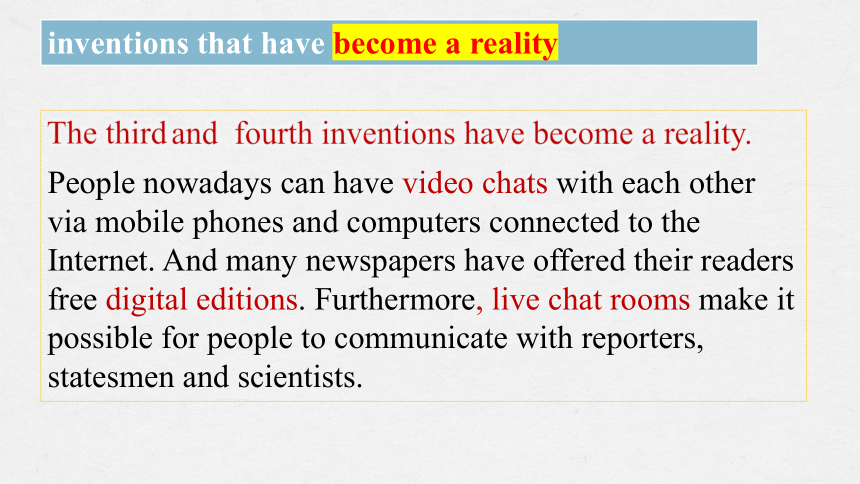

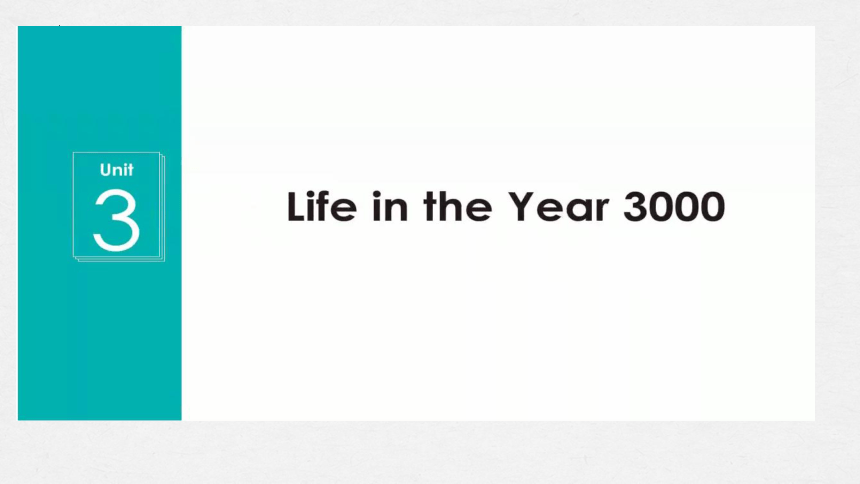
文档简介
(共26张PPT)
Unit 3
The world of science
Starting out & Listening&Speaking
By the end of this class, you will be able to:
know something about Alzheimer’s disease;
learn some listening skills to get useful information;
be able to understand and use relevant expressions to make a conversation about the invention of the telephone.
Learning objectives:
1.Have you ever read these novels
2.Have you noticed any inventions in the novels
Starting out
Activity1
Look at the pictures and answer the questions.
3.Read the inventions from these novels and choose those that have become a reality.
It is a fantasy novel written by British author J.K. Rowling. It is the first novel in the Harry Potter series and Rowling's debut novel.
The Time Machine is a science fiction novella by H.G. Wells, published in 1895 and written as a frame narrative. The work is generally credited with the popularisation of the concept of time.travel by using a vehicle that allows an operator to travel forwards and backwards in time. The term "time machine", coined by Wells, is now almost universally used to refer to such a vehicle.
In the Year 2889 is a 1967 science fiction film about the aftermath of a future nuclear war. A nuclear war has wiped out most of Earth's population. The film follows a group of survivors who are holed up in a secluded valley and must protect themselves from rising radiation levels, mutants, and in some cases, each other.
The Machine Stops is a science fiction short story by E.M. Forster. The story, set in a world where almost all humans have lost the ability to live on the surface of Earth and each individual lives in isolation in a “cell” relying on a giant machine to provide their needs, predicted future technologies such as instant messaging and the Internet.
inventions that have become a reality
The third and fourth inventions have become a reality.
People nowadays can have video chats with each other via mobile phones and computers connected to the Internet. And many newspapers have offered their readers free digital editions. Furthermore, live chat rooms make it possible for people to communicate with reporters, statesmen and scientists.
Watch the video and answer the questions.
1.Which of the inventions in the video interest you most Why
2.Which of the inventions in the video do you think will become a reality
3.Of all the inventions in the world, which do you think is the most useful why
Activity2
Watch a video to find out what is Alzheimer’s disease.
(AD) (阿尔茨海默病,老年痴呆症)
Alzheimer’s disease is a brain disorder that causes problems with memory, thinking and behaviour.
The majority of people with Alzheime’s are 65 and above. It is recognised as the most common mental disease among older people, and the number of sufferers is growing.
Currently, there’s no
cure for Alzheimer’s, but scientists
are researching ways to improve
the quality life for people living
with the disease.
Alzheimer’s disease
symptoms:
sleeping issue
disturbed memory
mood disorder
increasing confusion
dementia 痴呆
Listen to the conversation and number the pictures in the correct order.
1
2
3
4
5
Listening
7
Activity3
Listen again and complete the notes.
Activity4
Listen again and check the answers.
What is it
It’s 1.__________________________________________.
Who was it invented by
It was invented by 2.__________________called Kenneth.
Who inspired the invention
3.______________, who has Alzheimer’s.
How does it work
4._________is sent to a mobile phone like an alarm when the person with it 5.____________.
a student from New York
a pair of socks designed for people with Alzheimer’s diseases
His grandfather
A warning
gets out of bed
Mike: Hey, look! I’ve read about a cool invention in this magazine!
Anna: A pair of socks
Mike: Yes, but they’re not ordinary socks. This is a product designed for people with Alzheimer’s disease.
Anna: Oh yes, I saw a TV show about that. It was invented by a student from New York called Kenneth. He even won an award for it at a science fair!
Mike: Wow! How did he come up with the idea
Anna: Well, his grandfather has Alzheimer’s. He forgets things and gets lost easily. Once he got lost in the city and it took a whole day to find him! The family was always worrying about him leaving the house and had to keep an eye on him—even at night! Kenneth had been trying to find a solution. Then one night, he was looking after his grandfather and saw him get out of bed and step on the floor. That moment inspired him, and a good idea came to his mind.
Listening material
Mike: I didn’t know that! How did that moment inspire him
Anna: Well, it made him think of putting a device into a pair of socks to sense pressure. He started by drawing his ideas, and then he thought about how to power the device. Eventually, he created a device the size of a coin!
Mike: Like a coin So how does it work
Anna: He got his grandfather to wear the socks. When his feet touched the floor, the device sensed an increase of pressure, and a warning was sent to the boy’s mobile phone—like an alarm. That way, he could know his grandfather was getting out of bed without staying up all night.
Mike: How amazing! What a useful invention and caring grandson!
Anna: Yes, you are quite right.
You are going to give a presentation about the invention of the telephone. As part of your research, you speak to Student B who has just read a book about it. Ask him/her questions to find out more information.
Information you’d like to know:
the inventor
year of invention
the inventing process
the first phone call
other interesting things about the invention
Student A
Who invented..
When was… invented
How was … invented
What was the first phone call about
What other interesting things…
Useful expressions
Activity5
Work in pairs. Act out the conversation about the invention of the telephone.
Student B
You’ve just read a book about the invention of the telephone.
Student A, who is going to give a presentation on the same topic, asks
you for information.
Inventor: Alexander Graham Bell
Invention created in: 1876
Background: Bell was a teacher at a school for the deaf. He tried to invent a machine to send messages over an electronic wire. This eventually led to the idea of a telephone. Later, with his assistant, he created a device to produce and receive sound waves using electrical signals.
First phone call: On 10 March 1876, Bell made the first clear and complete phone call to his assistant, saying, “Mr Watson-come here-I want to see you.”
Other information: Bell never had a telephone in his study, where he wanted to be alone with his thoughts and work.
The telephone was invented by… in…
When…,he…
He later…, and finally…
The first phone call was about…
It is interesting that…
Useful expressions
Learning to learn
Exclamatory sentences express strong emotions, such as surprise, shock, joy, emphasis and excitement. These are usually formed with what or how, and in written form usually end with an exclamation mark.
Student A: Hi there! I heard you just finished reading a book about the invention of the telephone. I'm preparing a presentation on the same topic. Could you help me with some details
Student B: Of course, I'd be happy to help.
Student A: Great! Let's start with the basics. Who invented the telephone
Student B: The telephone was invented by Alexander Graham Bell.
Student A: And when was this incredible invention created
Student B: It was invented in 1876.
Student A: That's quite some time ago. How was the telephone actually invented
Student B: Well, Bell was a teacher at a school for the deaf. He tried to invent a machine to send messages over an electronic wire. This eventually led to the idea of a telephone. Later, with his assistant, he created a device to produce and receive sound waves using electrical signals.
Sample:
Student A: Fascinating! What was the content of the first phone call ever made
Student B: On 10 March 1876, Bell made the first clear and complete phone call to his assistant, saying, “Mr Watson-come here-I want to see you.”
Student A: That's iconic. Are there any other interesting facts about the invention or Bell himself
Student B: It is interesting that despite inventing the telephone, Bell never had one in his study. He wanted to be in alone with his thoughts and work.
Student A: Wow, that's really ironic and quite telling about his dedication to his work. Thanks so much for sharing all this; it's going to make my presentation much more engaging!
Student B: You're welcome! Good luck with your presentation.
学生A:你好!我听说你刚读完一本关于电话发明的书。我正在准备一个同样主题的报告。你能告诉我一些细节吗
学生B:当然,我很乐意帮忙。
学生A:太好了!让我们从基础开始。谁发明了电话
学生B:电话是亚历山大·格雷厄姆·贝尔发明的。
学生A:那么这个不可思议的发明是什么时候发明的呢
学生B:发明于1876年。
学生A:那是很久以前的事了。电话到底是怎么发明的
学生B:嗯,贝尔是一所聋哑学校的老师。他试图发明一种通过电线传送信息的机器。这最终导致了电话的想法。后来,他和助手一起发明了一种利用电信号产生和接收声波的装置。
学生A:太棒了!第一通电话的内容是什么
学生B: 1876年3月10日,贝尔给他的助手打了第一个清晰完整的电话,说:“华生先生,过来,我要见你。”
学生A:那是标志性的。关于这项发明或贝尔本人,还有其他有趣的事实吗
学生B:有趣的是,尽管贝尔发明了电话,但他的书房里从来没有电话。他想一个人呆在家里思考和工作。
学生A:哇,这真是讽刺,很能说明他对工作的投入。非常感谢分享这一切;这会让我的演讲更吸引人!
学生B:不客气!祝你的演讲顺利。
译文
Show Time
1.Retell the useful expressions of asking for and giving information.
2. How to use the relevant expressions to make a conversation about the invention of the telephone.
Summary
Homework:
Work in pairs. Choose another story of an invention you know and have a similar conversation.
THANK YOU
Unit 3
The world of science
Starting out & Listening&Speaking
By the end of this class, you will be able to:
know something about Alzheimer’s disease;
learn some listening skills to get useful information;
be able to understand and use relevant expressions to make a conversation about the invention of the telephone.
Learning objectives:
1.Have you ever read these novels
2.Have you noticed any inventions in the novels
Starting out
Activity1
Look at the pictures and answer the questions.
3.Read the inventions from these novels and choose those that have become a reality.
It is a fantasy novel written by British author J.K. Rowling. It is the first novel in the Harry Potter series and Rowling's debut novel.
The Time Machine is a science fiction novella by H.G. Wells, published in 1895 and written as a frame narrative. The work is generally credited with the popularisation of the concept of time.travel by using a vehicle that allows an operator to travel forwards and backwards in time. The term "time machine", coined by Wells, is now almost universally used to refer to such a vehicle.
In the Year 2889 is a 1967 science fiction film about the aftermath of a future nuclear war. A nuclear war has wiped out most of Earth's population. The film follows a group of survivors who are holed up in a secluded valley and must protect themselves from rising radiation levels, mutants, and in some cases, each other.
The Machine Stops is a science fiction short story by E.M. Forster. The story, set in a world where almost all humans have lost the ability to live on the surface of Earth and each individual lives in isolation in a “cell” relying on a giant machine to provide their needs, predicted future technologies such as instant messaging and the Internet.
inventions that have become a reality
The third and fourth inventions have become a reality.
People nowadays can have video chats with each other via mobile phones and computers connected to the Internet. And many newspapers have offered their readers free digital editions. Furthermore, live chat rooms make it possible for people to communicate with reporters, statesmen and scientists.
Watch the video and answer the questions.
1.Which of the inventions in the video interest you most Why
2.Which of the inventions in the video do you think will become a reality
3.Of all the inventions in the world, which do you think is the most useful why
Activity2
Watch a video to find out what is Alzheimer’s disease.
(AD) (阿尔茨海默病,老年痴呆症)
Alzheimer’s disease is a brain disorder that causes problems with memory, thinking and behaviour.
The majority of people with Alzheime’s are 65 and above. It is recognised as the most common mental disease among older people, and the number of sufferers is growing.
Currently, there’s no
cure for Alzheimer’s, but scientists
are researching ways to improve
the quality life for people living
with the disease.
Alzheimer’s disease
symptoms:
sleeping issue
disturbed memory
mood disorder
increasing confusion
dementia 痴呆
Listen to the conversation and number the pictures in the correct order.
1
2
3
4
5
Listening
7
Activity3
Listen again and complete the notes.
Activity4
Listen again and check the answers.
What is it
It’s 1.__________________________________________.
Who was it invented by
It was invented by 2.__________________called Kenneth.
Who inspired the invention
3.______________, who has Alzheimer’s.
How does it work
4._________is sent to a mobile phone like an alarm when the person with it 5.____________.
a student from New York
a pair of socks designed for people with Alzheimer’s diseases
His grandfather
A warning
gets out of bed
Mike: Hey, look! I’ve read about a cool invention in this magazine!
Anna: A pair of socks
Mike: Yes, but they’re not ordinary socks. This is a product designed for people with Alzheimer’s disease.
Anna: Oh yes, I saw a TV show about that. It was invented by a student from New York called Kenneth. He even won an award for it at a science fair!
Mike: Wow! How did he come up with the idea
Anna: Well, his grandfather has Alzheimer’s. He forgets things and gets lost easily. Once he got lost in the city and it took a whole day to find him! The family was always worrying about him leaving the house and had to keep an eye on him—even at night! Kenneth had been trying to find a solution. Then one night, he was looking after his grandfather and saw him get out of bed and step on the floor. That moment inspired him, and a good idea came to his mind.
Listening material
Mike: I didn’t know that! How did that moment inspire him
Anna: Well, it made him think of putting a device into a pair of socks to sense pressure. He started by drawing his ideas, and then he thought about how to power the device. Eventually, he created a device the size of a coin!
Mike: Like a coin So how does it work
Anna: He got his grandfather to wear the socks. When his feet touched the floor, the device sensed an increase of pressure, and a warning was sent to the boy’s mobile phone—like an alarm. That way, he could know his grandfather was getting out of bed without staying up all night.
Mike: How amazing! What a useful invention and caring grandson!
Anna: Yes, you are quite right.
You are going to give a presentation about the invention of the telephone. As part of your research, you speak to Student B who has just read a book about it. Ask him/her questions to find out more information.
Information you’d like to know:
the inventor
year of invention
the inventing process
the first phone call
other interesting things about the invention
Student A
Who invented..
When was… invented
How was … invented
What was the first phone call about
What other interesting things…
Useful expressions
Activity5
Work in pairs. Act out the conversation about the invention of the telephone.
Student B
You’ve just read a book about the invention of the telephone.
Student A, who is going to give a presentation on the same topic, asks
you for information.
Inventor: Alexander Graham Bell
Invention created in: 1876
Background: Bell was a teacher at a school for the deaf. He tried to invent a machine to send messages over an electronic wire. This eventually led to the idea of a telephone. Later, with his assistant, he created a device to produce and receive sound waves using electrical signals.
First phone call: On 10 March 1876, Bell made the first clear and complete phone call to his assistant, saying, “Mr Watson-come here-I want to see you.”
Other information: Bell never had a telephone in his study, where he wanted to be alone with his thoughts and work.
The telephone was invented by… in…
When…,he…
He later…, and finally…
The first phone call was about…
It is interesting that…
Useful expressions
Learning to learn
Exclamatory sentences express strong emotions, such as surprise, shock, joy, emphasis and excitement. These are usually formed with what or how, and in written form usually end with an exclamation mark.
Student A: Hi there! I heard you just finished reading a book about the invention of the telephone. I'm preparing a presentation on the same topic. Could you help me with some details
Student B: Of course, I'd be happy to help.
Student A: Great! Let's start with the basics. Who invented the telephone
Student B: The telephone was invented by Alexander Graham Bell.
Student A: And when was this incredible invention created
Student B: It was invented in 1876.
Student A: That's quite some time ago. How was the telephone actually invented
Student B: Well, Bell was a teacher at a school for the deaf. He tried to invent a machine to send messages over an electronic wire. This eventually led to the idea of a telephone. Later, with his assistant, he created a device to produce and receive sound waves using electrical signals.
Sample:
Student A: Fascinating! What was the content of the first phone call ever made
Student B: On 10 March 1876, Bell made the first clear and complete phone call to his assistant, saying, “Mr Watson-come here-I want to see you.”
Student A: That's iconic. Are there any other interesting facts about the invention or Bell himself
Student B: It is interesting that despite inventing the telephone, Bell never had one in his study. He wanted to be in alone with his thoughts and work.
Student A: Wow, that's really ironic and quite telling about his dedication to his work. Thanks so much for sharing all this; it's going to make my presentation much more engaging!
Student B: You're welcome! Good luck with your presentation.
学生A:你好!我听说你刚读完一本关于电话发明的书。我正在准备一个同样主题的报告。你能告诉我一些细节吗
学生B:当然,我很乐意帮忙。
学生A:太好了!让我们从基础开始。谁发明了电话
学生B:电话是亚历山大·格雷厄姆·贝尔发明的。
学生A:那么这个不可思议的发明是什么时候发明的呢
学生B:发明于1876年。
学生A:那是很久以前的事了。电话到底是怎么发明的
学生B:嗯,贝尔是一所聋哑学校的老师。他试图发明一种通过电线传送信息的机器。这最终导致了电话的想法。后来,他和助手一起发明了一种利用电信号产生和接收声波的装置。
学生A:太棒了!第一通电话的内容是什么
学生B: 1876年3月10日,贝尔给他的助手打了第一个清晰完整的电话,说:“华生先生,过来,我要见你。”
学生A:那是标志性的。关于这项发明或贝尔本人,还有其他有趣的事实吗
学生B:有趣的是,尽管贝尔发明了电话,但他的书房里从来没有电话。他想一个人呆在家里思考和工作。
学生A:哇,这真是讽刺,很能说明他对工作的投入。非常感谢分享这一切;这会让我的演讲更吸引人!
学生B:不客气!祝你的演讲顺利。
译文
Show Time
1.Retell the useful expressions of asking for and giving information.
2. How to use the relevant expressions to make a conversation about the invention of the telephone.
Summary
Homework:
Work in pairs. Choose another story of an invention you know and have a similar conversation.
THANK YOU
